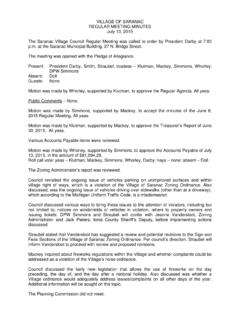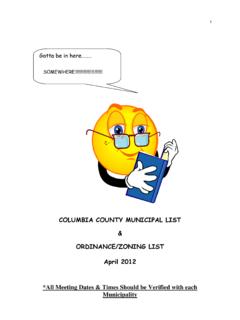Transcription of Amulike A Mahenge, Tanga City Council - World Bank
1 Amulike A Mahenge, Tanga city Council Urban Planning Department Box 178, Tanga . Tanzania E mail: Paper for Presentation at the Consultative Workshop for Upgrading of Unplanned Development and Unserviced Settlements in Dar es Salaam: 17th 18th May 2007. Title: Experiences of Regularization and of Upgrading Unplanned Settlements: The Case of Kwanjeka Nyota in Tanga city Abstract This paper provides a practical experience of regularization of unplanned settlements in Tanga city , as a reaction to development of unplanned settlements which was one of the environmental concerns identified and prioritized in Tanga city consultative meeting held on 11th 14th May 1999 it brought together 250 stakeholders from public, private and popular sectors within and outside the city .
2 Following the establishment of Sustainable Tanga Programme in 1997 with Environmental Planning and Management (EPM) process implemented under UNDP and DANIDA support, the stakeholders'. consultation formed issue-working groups on each identified environmental issue, resulting to the formation of upgrading unplanned settlements working group. The strategy adopted by the working group was to regularize and upgrade unplanned settlements through collaborative approach involving all stakeholders ( Tanga city Council , residents and facilitating utility agencies), which is in line with the National Land Policy of 1995 (URT 1995), National Human Settlements Development Policy of 2000 (URT,2000) and the Land Act of 1999 (URT,1999).
3 Regularization of unplanned settlements would entail process of securing security of tenure, provision of infrastructure and community facilities, and making plots available for urban development in order to prevent further development of unplanned settlements. Realizing and taking into account the inadequacy of public sector resources, the working group agreed that, any adversely affected person in the process would not be financially compensated but instead would be relocated to an alternative plot by the city Council . Sub working groups were formed at sub ward level to facilitate regularization process at this level, demonstration settlement was identified, and its experience replicated to other settlements.
4 Kwanjeka Nyota unplanned settlement in Mzingani Ward was selected for demonstration. This paper outlines the background, objectives, organization, implementation, emerging challenges, lessons of experience from this empirical case of Tanga city , recommendations and way forward for future regularization of unplanned settlements. 1 Background Tanga city ,which is situated in the eastern coast of Tanzania along the Indian, Ocean covers an area of 600 square kilometers, and conveniently accessible from Dar es Salaam (360km south). The city is the regional administrative center, commercial hub and the second largest port in the country.
5 The city is subdivided into 24 administrative wards. The Projected city population by 2007 based on the 2002 Census is 265,549 people with an average annual growth rate of per cent. Fifteen urban wards accommodate 78%. people while 22% of the total population lives in 9 rural wards consisting of 23 villages. The population growth rate is due to natural population increase and sustained rural urban migration following privatization of manufacturing industries and construction of new industries such as Pembe Flour Mills Ltd, Arthi River Manufacturing (T) Ltd, Sea Products Ltd and Tanga Pharmaceutical Ltd, only to mention a few.
6 The development approach of Tanga city Council (TCC) has, been relying on the Tanga Master plan (1985-2005) since 1985 However, the city development has experienced inherent problems associated with the implementation of the plans such as sole dependency on merger resources from government, coupled with increased population demands, in exclusion of other stakeholders with their potentials. As a result, planning was ineffective in guiding city development and it led to unplanned settlements, deterioration of state of environment such as poor solid and liquid wastes management that called for a new planning and management approach to counteract the emerging trend.
7 Development of unplanned settlements is the result of the failure of formal housing delivery system to accommodated increasing urban population, incorporation rural areas within the city boundaries which has opened informal land markets, where the customary landowners parcel and sell out land to urban land seekers in response to cumbersome bureaucratic procedures in acquiring planned and surveyed plots coupled with high and unaffordable building standards set by conventional planning practices. There are twenty four unplanned settlements in the city with names of wards in Brackets1.
8 They are characterized by lack of land set aside for infrastructure, poor circulation depending on 1non standardized and uncoordinated roads and footpaths and further hampered by the haphazard patterns of buildings, lack of drainage facilities, poor sanitation; many houses are not connected to piped water or electricity and lack of security of tenure. Unplanned settlements in the city accommodate 23% of urban population 47, 639. people while 77% of urban population is living in planned areas. The percentage of population living in unplanned settlements in Tanga city is lower compared to other urban areas like DSM where 70% of the population lives in unplanned settlements.
9 This can be attributed to the collapse of sisal industries and decline of industries activities in the city in 1980s to 1990s, which were providing employment to urban population. 1. Gofu juu (Nguvumali), Magomeni A, B and C, Mjimwema and Mapinduzi (Duga), Mwakizaro and Mwanzange (Mwanzange) Chumvini (Chumbageni), Kwanjeka Nyota, Majengo, Kwanjeka A, Gezaulole and Mtambwe/ Kiungani (Mzingani) Mtakuja (Makorora), Magaoni A and Swahili (Mabawa), Tangasisi, Mwahako, Mwakidila, Mwang'ombe and Masiwani (Tangasisi) and lastly Usagara Kijijini (Usagara). However, the situation is changing due to the increased economic activities in the city , which is attracting people to look for employment.
10 The change has been caused by revival of the industrial sector through private ownership, where privatized industries such as Steel Rolling Mills, are operating and giving employment to urban population. Since then, the environment has been attracting people to seek for employment and this is resulting to increase of demand for housing. The change is indicated by the action of TCC demolishing 900 houses which were constructed by squatters in planned area and surveyed for export processing in the year 2006. Global policy changes on addressing unplanned settlements More than three decades of experience with upgrading show that governments have moved away from eradication and eviction policies that advocated the bulldozing of these settlements and relocation of families to other areas where conventional housing or sites and services schemes were carried out.














